Previously:
Further thoughts on Fly Fishing
The Dry Fly
Since joining the Wharncliffe Fly Fishing Club, I have done a lot more dry fly fishing than I usually do. This is because this little Victorian reservoir has a plethora of terrestrial insect life around it, especially hawthorn and heather flies. There are also the “Curse of Wharncliffe” – aphids or greenfly, which often the trout become preoccupied with. Tying an imitation to suggest these little beasties isn’t easy. My friend – David van der Merwe, ties a most wonderful little fly on a size 22 hook which often does the business for him. For myself I tie something similar, short, on a sixteen hook.
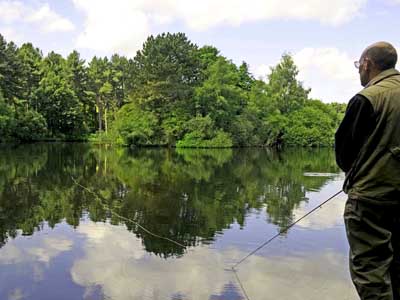
Dave van der Merwe waits patiently for an offer on his dry fly, but there to the right is a rise…
Being a catch and release water, the trout of Wharncliffe soon wise-up if your dry fly presentation is not 100%. This means fine leader tippets, delicate casting and making sure that the tippet sinks as soon as it touches the water, even in a flat calm.
Those of you who have done a bit of dry fly fishing, especially those who have taken the trouble to go beneath the water and look at what a floating monofilament leader looks like will know what I mean. No self-respecting trout is going to take any fly with what looks like a floating water snake attached to it.
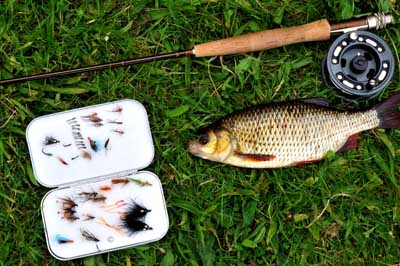 So how do we get that leader under the water quick? We can of course use fluorocarbon, which is quite a bit heavier than nylon and sinks quite quickly. But even this stuff will float in the surface film on a calm day. OK so we can help the fluorocarbon to sink by degreasing it using a proprietary degreaser such as Dick Walker’s Ledasink. This is putty made with Fuller’s earth, washing up liquid and glycerine. You can make it up yourself, but since a small tub of this stuff only costs me a pound, I don’t bother. But even this sort of treatment often fails and the leader still floats.
So how do we get that leader under the water quick? We can of course use fluorocarbon, which is quite a bit heavier than nylon and sinks quite quickly. But even this stuff will float in the surface film on a calm day. OK so we can help the fluorocarbon to sink by degreasing it using a proprietary degreaser such as Dick Walker’s Ledasink. This is putty made with Fuller’s earth, washing up liquid and glycerine. You can make it up yourself, but since a small tub of this stuff only costs me a pound, I don’t bother. But even this sort of treatment often fails and the leader still floats.
An unusual catch for Ron, a 1½lbs rudd.
There are those who would put on a small sinking fly such as a Diawl Bach on a dropper further up the leader. This is often called the “washing line technique”. It works very well on the large reservoirs on newly released stockies, but often has no effect on wised up mature rainbows and browns who are dressed in dirty T shirts.
Personally, for these sorts of fish, I prefer to fish one fly only and to use a tiny amount of Uncle Dave’s Ultra Heavy Metal tungsten putty twiddled on the tippet about 12 to 18 inches away from the fly. This provides the ideal solution, as the bit of weight is tiny and unobtrusive. You will often have to balance the sinking effect of the putty with the buoyancy of the fly to get it right, too much putty and the fly will sink, too little putty and the line will float.
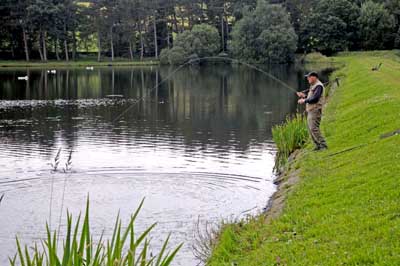
Dave van der Merwe plays a nice trout taken on a small black beetle pattern
You would be surprised at the strength of the buoyancy effect in the surface tension of water, especially in a flat calm. There is also the phenomenon of what is called a “Wind Lane.” On large lakes these “calm lanes” are often seen. Fish like to swim near the surface along these lanes, especially at the edge of the ripple.
But what causes these “wind lanes”?
Personally, I think wind lanes are caused by mass eclosions of midge pupa (buzzers), leading to traces of oily substances at the surface of the water. We have all seen the effect of even a tiny oil slick on the surface of a lake, even one with a fair old chop on it. Try depositing a bit of canned sardine or a sea dead bait into the water.
I have been spending a lot of time devising dry flies of late. First of all to attempt to imitate the tiny aphid (greenfly) insects that are blown onto the surface of Wharncliffe Reservoir. As mentioned previously, these have been tied short on size 16 hooks. The only problem here is that a size 16 hook is not really up to landing big blue or brown trout weighing up to double figures. Therefore I have been using various dry fly patterns such as Daddy longlegs, Sedges and “F” Flies tied to size 12, 10 and 8 hooks and very successful they have been too, especially if the dressing has incorporated a touch of green. My idea behind the use of a large dry fly is to appeal to the greedy nature of trout. Amidst a field full of grass there grows a huge succulent stalk which a hungry cow will head for first. 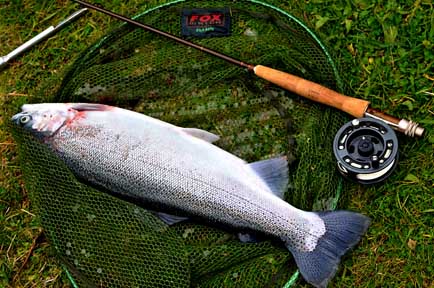
In fact a little while ago I caught a fin and scale perfect blue trout of 7¼ lbs (picture right) which swallowed the dry fly completely and was bleeding badly from the gills when I netted it, after one of the best scraps I have ever had with any trout in my life.
The dressing of the fly is as follows:
Hook: 10 sproat
Thread: Sparton Brown 8/0
Tails: 3 to 5 pheasant centre tail fibers.
Body: About 4 cock pheasant tail fibers twisted and wound over wet varnish.
Rib: Fawn polyester thread.
Hackle: Brown henny cock, about 4 turns.
Wing: Bunch of natural CDC tied in at head sloping back and clipped.
To fish this fly, use a length of 9lb mono tied to about 3 feet of 5 lb fluorocarbon mono, making up a leader and tippet of about 10 feet long. Rub this leader down with Dick Walker’s Leda sink and Gink up the fly. Apply a tiny amount of Krypton Ultra Heavy Metal and twiddle it between thumb and forefinger, applying it to the leader tippet about 18 inches from the fly. If there is too much Heavy Metal, remove a bit until you get a nice balance between the floating fly and the sunken tippet.
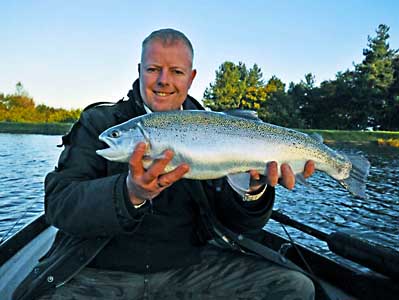
Shane with a beautiful 7lbs blue caught on a Cat’s Whisker.
When the tippet is sunk, the trout cannot see it and the fly is often taken with gusto. Ask my friend Shane (Cat) Calton, he is sold on it.
Fly Fishing Matches
Writing in his column in the magazine: “Total Fly Fisher”, my friend Steve Parton gives the match fly fishing fraternity a hard time regarding their commandeering of large reservoirs whenever a match is in progress. This has resulted in the notion, according to Steve, that trout fishing on large reservoirs couldn’t exist without match fishermen. Steve says “Balderdash” (or something worse) to that, and do you know, I tend to agree with him.
What is happening is that on weekends – times when matches are mostly in progress, the normal pleasure angler is giving up fishing these waters and has moved to the numerous smaller fisheries.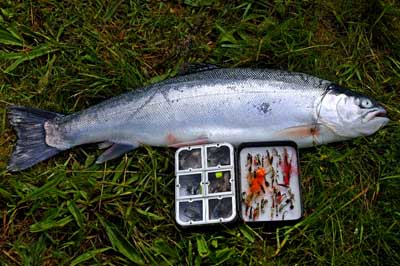 Read any trout fishing magazine these days and you will find it full of match tactics and match fly patterns, designed not to be longer than 25mm and designed to hammer out stockiest as fast as possible. And don’t tell me such patterns are not effective stockier bashers – they are.
Read any trout fishing magazine these days and you will find it full of match tactics and match fly patterns, designed not to be longer than 25mm and designed to hammer out stockiest as fast as possible. And don’t tell me such patterns are not effective stockier bashers – they are.
For those of you who are not familiar with match rules for boat fishing, the only methods allowed are designed to prevent you targeting the large over wintered rainbow and brown trout that abound in large reservoirs. Occasionally, a match angler catches one of these specimens. But by far the majority of fish caught by these people are yesterday’s stockies.
But you won’t get the match fraternity using rudders, lead cored lines and big fish imitating flies that will, in the right hands, catch “men’s fish”. In fact you don’t see many articles on big fish tactics at all these days. What you will see are articles on blobs and how to rip them back along with other flies called Cormorants and shortened boobies – stocky bashers all!
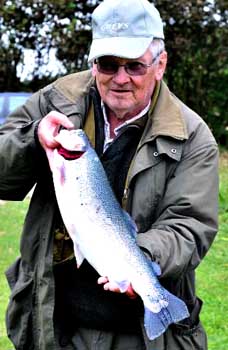 Way back in the 70s, the legendary Fred Wagstaffe was severely criticized for using a fly called a “Waggy” which consisted of a tandem hook, and a rubber wiggle tail to imitate the big brown trout’s natural food. Personally I think he was without blame and was only “matching the hatch” as it were, that is imitating the trout’s natural food. Many of the flies used by match anglers these days imitate nothing on earth. I often smile when I hear a few of them say that the blob represents a patch of daphnia. Well I’ve never seen daphnia moving at 3 feet a second, have you?
Way back in the 70s, the legendary Fred Wagstaffe was severely criticized for using a fly called a “Waggy” which consisted of a tandem hook, and a rubber wiggle tail to imitate the big brown trout’s natural food. Personally I think he was without blame and was only “matching the hatch” as it were, that is imitating the trout’s natural food. Many of the flies used by match anglers these days imitate nothing on earth. I often smile when I hear a few of them say that the blob represents a patch of daphnia. Well I’ve never seen daphnia moving at 3 feet a second, have you?
And then there are traditional patterns, the Mallard and Clarets, the Black Pennells, the Teal and Silvers. The Greenwell’s Glories – ad nauseum.
None of these things look like anything a trout eats, yet many trout anglers will not even raise an eyebrow if you are seen fishing with them.
Ron Clay













